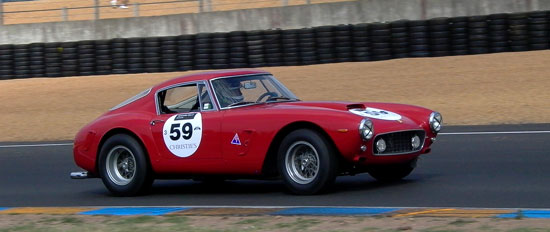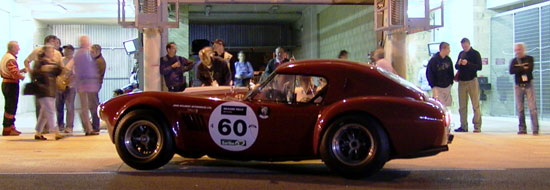
Over 50,000 visitors attended the second running of the Le Mans Classic, held last weekend at the famous 24 Hours circuit. Featuring more cars and activities, everyone who went agreed it was a tremendous success and must be repeated in 2006.
As we have previewed, the event is split into 6 grids, or ‘Plateaus’, comprising up to 60-odd cars, who then have three races of 45 minutes each over the 24 hours. In addition to individual race wins, cars can battle for an overall win (by totalising the results of the three rounds) and the legendary ‘Index of Performance’, a handicap of fiendish complexity that allows the smaller, or slower, cars to battle with the big boys. There’s also a ‘Team Prize’ for collections of cars over the six grids.
It’s not the place of Classic Driver to give you the minutiae of each race, the excellent Le Mans Classic 2004 website will shortly have all the results, but we can give you a feeling of what it was like trackside, and whether it’s worth making a reservation for next time. Dealing with latter swiftly, a resounding - Yes!
Whatever the competitors may have thought of the paddock layout, and the complexities of re-fuelling, scrutineering and grid formation, the net result for the spectator was an atmosphere like no other, with the glorious site of big-capacity 1970s sports cars, like the Ferrari 512M below, being pushed or driven around the paddock, jostling with GT40s or pre-war Alfa 8Cs. The café by the pits complex became a meeting-place, and one could while away an hour or so chatting to friends while seeing an endless parade of the most fantastic cars passing by, often accompanied by drivers famous for their exploits on the circuit over the last 50 years.
 |
 |
No one could fail to be be moved by the paddock scene at night - say 0200hrs - the pits a hive of activity, sodium lights glowing brightly and on the track the roar of multi-cylinder racing engines from years gone by. Having only 45 minutes per round meant the racing could be quite close; and if not, the next grid was not so far away and a visit to the collecting area on the Bugatti circuit meant you could get very close to the action.
In most people’s opinion ‘Plateau 3’ was the most exciting round, although all races had their moments of interest. ‘3’ was for cars from the 1957 - 1961 period, and the top six places were disputed over the three rounds by the Tim Samways-prepared 1960 Ferrari 246 S Dino of Tony Dron, joined by Peter Hardman for the final race only, (the Aston Martin DBR1 he was due to share with Aston Martin CEO Dr Ulrich Bez having broken its gearbox in race 1) and Nick Linney’s Lister Jaguar, closely followed by Aston Martin Project 212, Nick Whale’s famous E-Type ‘Cut 7’, Vincent Gaye’s fabulous silver/yellow 250 SWB Ferrari and the very fast and reliable DB4GT of Thornton/Garrett. Honours probably should have gone to the Dino but bad luck in the night race meant Tony (driving solo for this round and leading by 24 seconds), was stuck in the pits during a pace-car incident and simply lost too much time, overall victory going to the Lister (despite a superb Sunday morning race from the Dino team, when they won by 20 secs after 9 laps). The Aston Engineering-prepared DB4GT could well have been third overall if the car had not lost second gear in the final stages of the event.
As the Aston's co-driver, David Garrett, said of his time at Le Mans “We had a fantastic and event-packed weekend, got 4th overall and 2nd on index (exactly the same as ‘02, but in much-elevated company), and for the icing on the cake got awarded the special prize for best Aston! Doesn't come much better than that!” It certainly doesn’t - a great effort.
Pace-cars featured throughout the weekend and it was a shame that some of the rounds were held under lengthy yellow-flag periods. But safety is all: and the circuit can be dangerous. Jaguar C-Type driver Neil Hadfield suffered burns and badly broken bones when, taking avoiding action after an Allard lost its bonnet in Plateau 2, he hit a barrier on the Mulsanne and overturned the car. Plateau 2 was eventually won by ex-F1 driver (and past 24 Hours winner) Johnny Herbert in a C-Type, chased all the way by veteran British drivers John Harper and Barrie Williams in a ‘D’.
The pre-war race was a fairly easy one for the 1937 BMW 328 of Feierabend and Franssen, but a performance of note was the two Aston Martin Speed Models finishing 3rd and 4th, just 50 secs apart after three races.

Plateau 4 onwards saw the really fast stuff arrive. For those used to seeing GT40s on chicane-blighted British circuits this was a real eye-opener. The speed of all the proper ex-Le Mans cars like the GT40, Porsche 904 and AC Cobra was awesome. Bill Binnie just won this category from the similar GT40 of Hugenholz/Tambay/Ibing. Two Porsche 904s were 3rd and 4th.
The next grid was even faster. For cars raced between 1966 and 1971, it featured yet more GT40s (like the subject of our Classic Car of the Week feature last time) as well as Lola T70s, Porsche 908/3s and small-capacity prototypes from Lola and Chevron. As John Mayston-Taylor (who drove the yellow, ex-Yamaha GT40) says “To be next to the Sunoco Ferrari 512M on the Mulsanne straight is just unforgettable. An incredible experience I want to do again.” Some of the faster machinery could not take the pace, and the much-anticipated Porsche 917 was a non-starter, but the spectacle was still unbelievable.
New for 2004 was the addition of cars from 1972 to 1978. Fastest by far for the whole weekend, this grid saw a recreation of the Porsche vs Renault battles of the late ‘70s. In fact it was three ex-works Renault drivers against former 24 Hours winner Jürgen Barth in the Martini Porsche 936. Add in Jean-Claude Andruet in the Inaltera and an amazingly fast 1976 Lola T286 3-litre Cosworth and you had some seriously quick, well-driven machinery. If, as a spectator, one was tempted to say ‘I could do that’ looking at the Healeys, Morgans and DB2s, I defy anyone to repeat that statement with Plateau 6. Big boys stuff. Final victory going to the German car, as it did in 1976.
Of course in addition to the racing there were more than 4,000 classic cars on display by the 100 car clubs involved with the meeting, a superb, record-breaking Christie’s auction and some new-car manufacturer involvement that saw the Ford GT, Aston Martin DB9, Ferrari Enzo and new Porsche 911 given demonstration laps on the circuit. It was also one of those occasions when just walking through the paddock one could meet friends from all over the world.
This is now a ‘must-do’ event that ranks right up there with the best. For amateur and professional alike it was an unforgettable experience. Tony Dron, who has competed many times at the main event in June, was driving the Ferrari 246 S Dino, the car that finished 2nd in the 1960 Targa Florio. He described leading the pack at night, on the classic circuit, lights blazing ahead along an empty track as “Absolutely fantastic, despite all the changes to the circuit this is a magical place”.
You couldn’t add to that.
Text - Steve Wakefield
Photos - Classic Driver STRICTLY COPYRIGHT
 |
 |
 |
 |
 |
 |
 |
 |
 |
 |
 |
 |
 |
 |
 |
 |
 |
 |
ClassicInside – The Classic Driver Newsletter
Free Subscription!


